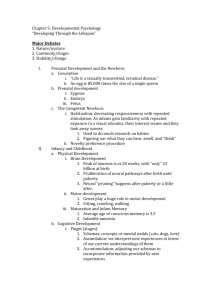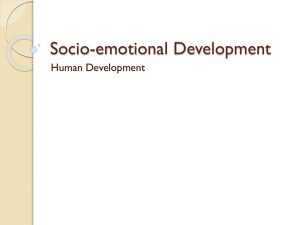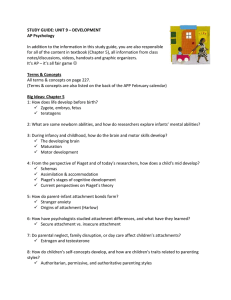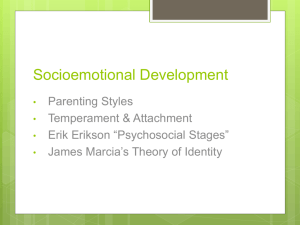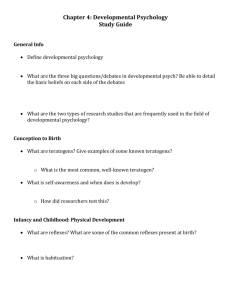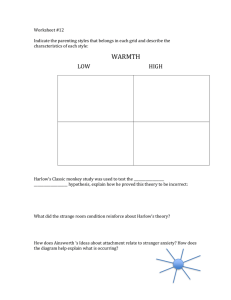Unit 7 – Social Development
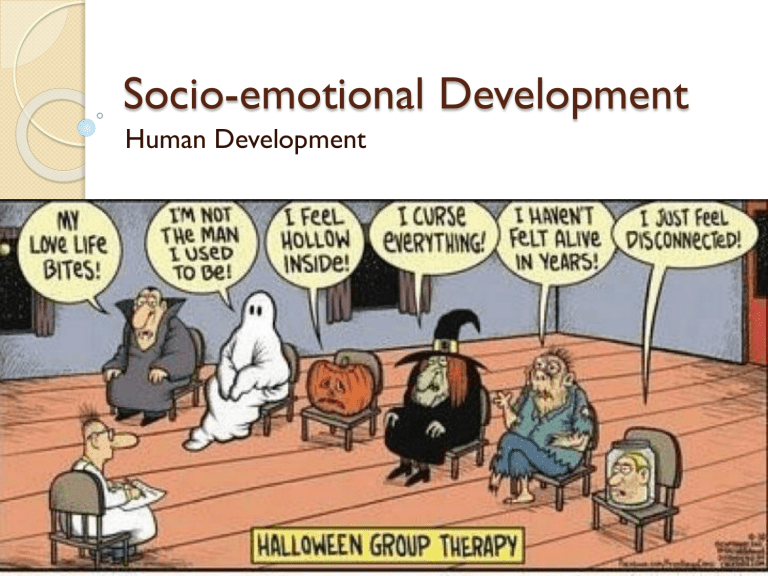
Socio-emotional Development
Human Development
Understanding Human Development
Development – Continuity and change in human capabilities over a lifespan.
◦ Physical
◦ Cognitive
◦ Social
◦ Emotional
Issues in Developmental Psychology
Issue
Nature/Nurture
Continuity/Stages
Stability/Change
Details
How do genetic inheritance (our
nature) and experience (the nurture
we receive) influence our behavior?
Is developmental a gradual, continuous process or a sequence of separate stages?
Do our early personality traits persist through life, or do we become different persons as we age.
3
Temperament
Temperament refers to characteristic patterns of emotional reactions and emotional self-regulation
Thomas and Chess identified three basic types of babies
◦ Easy
Good-natured, easy to care for, adaptable, regular behavior
◦ Difficult
Moody and intense, react to new situations and people negatively and strongly, cries a lot, irregular behavior
◦ Slow-to-warm-up
Inactive and slow to respond to new things, and when they do react, it is mild, inflexible behavior
Kagan has added a fourth type
◦ Shy child
Timid and inhibited, fearful of anything new or strange
Temperament may predict later disposition
Temperament
New research suggests we should look out children's abilities in terms of
◦ Effortful control (self-regulation)
◦ Inhibition (Shyness in social situations)
◦ Negative Affectivity (how easily frustrated)
Cultural differences
◦ 4-day-old with cloth over face
◦ European American: struggled
◦ Chinese American: calmer
Genetic and environmental influences
◦ Womb
◦ Day care
Attachment
Emotional connection we share with those we feel closest to
◦ Imprinting – Konrad Lorenz
◦ Critical periods – John Bowlby
◦ Contact Comfort – Harry Harlow
◦ Forming Attachment – Mary Ainsworth
Attachment Theory
Konrad Lorenz discovered that some animals form attachment through imprinting –
Necessary biological attachment to caregiver
Attachment Theory
Looks at the dynamics of long-term relationships between people
Imprinting (Lorenz) mixed with the idea that an infant needs at least one primary caregiver for socio-emotional development to occur.
Came out of studies of orphaned and homeless children after
WW2 (John Bowlby)
◦ 6 months – 2 years (Critical Period)
Consistency and sensitivity of caregivers seems to be the key
With this they can form a secure base to interact and respond to others as they get older. The initial attachments determine the internal models (perception, emotions, thoughts, expectations) in later relationships.
Reinforced by the work of Ainsworth. (Secure Base)
◦ Has been extended to adult behavior including romantic and sexual attraction, as well as how adults care for their own children.
Attachment
•
•
•
Critical Periods: the optimal period shortly after birth when an organism’s exposure to certain stimuli or experiences produce proper development.
Those who are deprived of touch have trouble forming attachment when they are older.
Imprinting (Lorenz) occurs during a critical period
Click on the monkey to see what a baby monkey does when he HAS attachment and imagine what it is like when he does not (like above).
Harry Harlow – Displayed our need for social attachment with the use of Rhesus Monkeys
Relates to human issues in:
Withdrawal
No sexual relations
Ignored & abused infants
Harry Harlow’s
Study
Forming Attachments
Mary Ainsworth Studies
Secure Attachment – infants use mother as a base from which to explore
Usually attach to mother first
◦ Caregiver
◦ Calming force
Attach to father later
◦ Playmate
Strange Situation Study
Studies infants response to separation from their mother
Separation Anxiety – Infant will cry when primary caregiver is removed
Stranger anxiety – develops at 8-9 months, peaks at 1 year
Strange Situation Results
•
Three types of attachment:
Securely attached babies
◦ distressed when separated from mother, but easily soothed
Insecure-avoidant
◦ Indifferent when mother leaves
◦ Doesn’t react upon return
Insecure-anxious
◦ Panic when mother leaves
◦ Ambivalent upon return
Disorganized
◦ Inconsistent, dazed, confused
Criticisms of Strange Situation
Mono-operation bias : drawing conclusions on the basis of only a single measure
Not very reliable
Different attachment with mother than father
Children might elicit parental attachment behaviors
CLICK
Social Development
THE ROLE OF
PARENTING
Parenting Styles
* Diana Baumrind *
Permissive
◦ Lenient, lots of freedom not a lot of discipline. Children have poor social competence and are disrespectful, impulsive
Authoritarian
◦ Very strict, lots of punishment, little affection. Sometimes lack social skills, poor initiative, and compare themselves with others.
Authoritative
◦ Happy medium – supportive but set limits. Children are self-reliant, socially competent, responsible
Uninvolved
◦ Neglectful, children feel less important, lose social competence
Parenting
Cultural differences
◦ Individualistic: better with authoritative
◦ Collectivist: better with authoritarian
Average expectable environment
◦ Provide basic needs for affection and discipline
What about …..
◦ Peers?
Group socialization theory
◦ Dad?
◦ Single parent homes?
◦ Homosexual parents?
◦ Divorce?
Self-Control
Ability to inhibit an impulse to act
Delaying gratification at young age predictive of future coping abilities
Socioemotional Development
LAWRENCE KOHLBERG VS.
CAROL GILLIGAN:
HOW DO WE DEVELOP MORALS?
Moral Development
Kohlberg (1958) – asked a series of questions about moral scenarios.
Answers to moral dilemma from participants were used to display moral development.
The Famous Heinz Scenario
Kohlberg’s Theory of Moral
Development
Studied the development of children’s moral thinking
Follows a sequence and do not skip stages or go backwards
Advance at different rates
◦ PRECONVENTIONAL Base decisions on the consequences of behavior
Stage OneWhat is good helps you avoid punishment (Punishment and
Obedience)
Stage TwoWhat is good satisfies a person’s needs (Instrumental Exchange)
◦ CONVENTIONAL Decisions conform to society
Stage ThreeDo things to win approval (13 yrs) (Interpersonal Conformity)
Stage FourDon’t do anything that’s against law and order (16yrs)
◦ POSTCONVENTIONAL Decisions based on your values (adults)
Stage FiveObedience to accepted laws based on personal values (Social
Contract and Prior Rights)
Stage SixDecisions based on moral beliefs without concern for laws (Universal
Morals)
Carol Gilligan
Argued that Kohlberg did not give adequate attention to relationships
◦ Gender bias involved
Showed Kohlberg came from a justice perspective, not a care perspective (her approach)
Gilligan puts more emphasis on interpersonal communication, relationships, and concern.
Human Moral Development
Supportive parenting and parental monitoring connected to pro-social behavior in children
Ability to engage in self-control also shown to connect to willingness to empathize (Eisenberg, 2010)
When do children develop a conscious?
Social Development
ERIK ERIKSON’S
THEORY OF SOCIAL
DEVELOPMENT
Erik Erikson
A neo-Freudian
Worked with Anna
Freud
Thought our personality was influenced by our experiences with others.
Stages of Psychosocial
Development.
Each stage centers on a social conflict.
Erikson
Four stages in childhood, four after puberty.
Shows that socio-emotional development occurs throughout a lifespan
Focus on gaining competence and maturity
At each stage the person must master a developmental task.
◦ If not met can carry these concerns throughout life
Erikson Evaluation
A giant in the field of development
Only used case study research and evidence, so lacks foundation.
Leaves out some developmental tasks
◦ Work and career during young adulthood
Socioemotional Development
SOCIAL DEVELOPMENT
IN ADOLESCENCE AND
ADULTHOOD
Adolescence
The key lies in the search for identity as the brain fully develops.
Biological-Socioemotional crossover period
Identity Status is formed through exploration, experimentation and commitment
◦ Identity Achievement
◦ Identity Moratorium
◦ Identity Foreclosure
◦ Identity Diffusion
Emerging Adulthood
Emerging transitional period
◦ 18-25 years patterned by a focus on the self, being “in-between”, and instability in various aspect of life.
Early Adulthood = Point of Marriage
◦ Nurture fondness and admiration
◦ Turning toward each other as friends
◦ Giving up some power
◦ Solving conflicts together
Adulthood
Middle Adulthood
◦ Preventing the midlife crisis through
Generativity
◦ Engaged parenting is one way to due this
Late Adulthood
◦ Need to look back and evaluate life’s meaning
◦ Ego Integrity vs. Despair (Erikson)
◦ Meaning is a central focus of the elderly
Maximize life’s experiences
